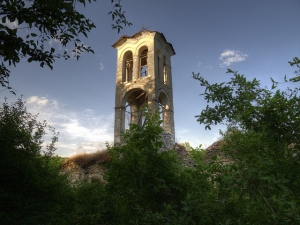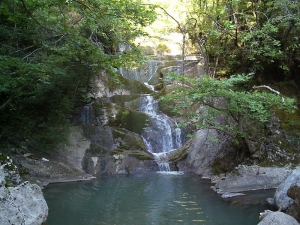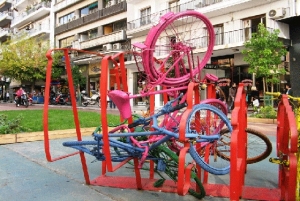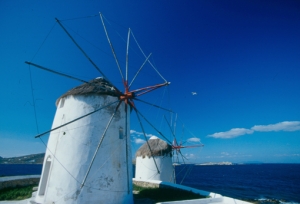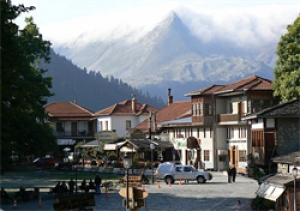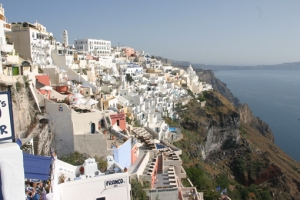ABOUT US
XpatAthens
High Mountains Of Pinos, Great For Trekking
The photo is of Perivoli. This is just a rough start to the presentation of a huge Greek region, Pindos, which extends from Northern Greece down to Attiki. To this region belong many of the high mountains of the Greek mainland, such as Smolikas. The reason for this introduction is that Pindos was my first mountaineering-trekking experience, some 10 years ago - and a revelation, since I have always been a "person of the sea-side". It is needless to mention the beauty of Pindos. No-one can understand this beauty, except if one gets there - which we wish to everyone.
Flora - Fauna - Climate
The landscape is on a grand scale with peaks of limestone and serpentine rock rising to 8200 ft from an extensive region of natural beech and pine forest at the headwaters of the Vikos and Aoos rivers. Although the climate is warm in summer, the Pindos mountains remain green long after the winter snows have thawed. In spring and early summer meadows are ablaze with alpine and other wild flowers, including an amazing abundance and variety of orchids. Towards autumn as the leaves begin to turn, just as colorful are the forests of beech and hornbeam. Overall, perhaps the greatest attraction of the Pindos mountains is that one can find a greater solitude here than in many other mountainous areas of Europe. Our route on this part of the trek followed shepherds' and muleteers' footpaths, ancient tracks and some newer Forestry Service access roads.
The Pindos region is thinly populated and much of the lower ground is still covered by dense forest within which live wolves, bears and lynx. Griffon vultures soar above the peaks, while Egyptian vultures haunt the gorges.
The high alpine pastures are grazed in summer by flocks of sheep, which are milked to produce the many excellent local cheeses such as kefalotiri.
Level of difficulty:
This trek is designed for those who are in good physical condition, take regular exercise and enjoy hill-walking. It will be necessary to carry usual day-sack contents, minimum overnight requirements and some food.
Equipment and clothing:
If you are already a hillwalker you will probably have all the clothing and equipment you need. The climate is warm at low altitude and light clothing should be brought, as well as warm, and stormproof clothing for high-level walking. A sheet liner is needed for the nights in huts and a sleeping bag of about 3 season warmth is needed for camping on Smolikas.
Drama
On the foot of the imposing Falakro mountain and in a lush green area full of running waters lies the city of Drama. It is a beautiful and welcoming city with scenic neighborhoods, broad squares, green areas and well preserved neoclassic mansions. Few archeological findings prove that in the area of the modern city used to be Dirama or Idrama settlement, where people worshiped Dionysus, Apollo, Artemis, Isida and Hercules.
A tomb complex dating back to the Iron Era was found in the area of Drama's Industrial Zone. A Macedonian tomb of Hellenistic times which was found in the city, close to Dikastiria square, proves that the city has been inhabited since the historic times.
During the middle Byzantine era (9th-13th century) Drama was fortified with a castle and was commercial and a military junction. By the end of 19th century, the tobacco production and trade, the operation of the railway (1895) and the improvement of the road network towards Kavala port led to the increase of the city population and the boost of its commercial activity. In the beginning of the 20th century, Drama was under Bulgarian occupation and participated in the Macedonian War of Independence. It was liberated on 1st of July, 1913 by the Greek army. Drama is located 688km NE of Athens and 175km NE of Thessaloniki.
The rich forests of the prefecture, which is made up of mountain slopes, rivers and caves, churches, monasteries, castles and bridges come together to make up a unique area in terms of prosperity while at the same time offering a variety of things for a tourist to do. Such a wealth of natural and manmade beauty and history throughout the whole Prefecture calls upon us to explore it and get to know it better.
To read more, please visit drama.gr
Arcadia
In agriculture, potato farms (dominant in central and north-central Arcadia), mixed farming, olive groves, and pasture dominate the plains of Arcadia, especially in the area around Megalopolis and between Tripoli and Levidi.
Towns & Sights
Tripoli, the capital of the prefecture, is built at a height of 665m. It is the commercial and cultural center of Arkadia. Modern Tripolis was created in 1770 near the ruins of the ancient cities of Pallantron, Tegea, and Mantinea, hence its name 'Tripolis' = 'three cities', presumably chosen to explain the medieval name. Before the Greek Revolution, it had a large Muslim and Jewish population, but also served as the central point for Ottoman occupation and rule over Greece. Today it is the seat of the recently founded University of the Peloponnese with two departments of the Sciences and Technology School and one department of the Economics and Administration School.
Astros is a breathtaking town by the sea built upon a hill called the " To Nissi " An open theater is operating there during the summer months. There is also a sailing school for adults and children and the harbor full of little sailing boats is a sight to behold.
The town is also home to the Astros Archaeological Museum, founded in 1985. The museum contains mostly ceramics from cemeteries dating back to the Hellenistic period, architectural parts of the villa of Herodes Atticus at Eva Dolianon, and small coins, inscriptions and pieces from Kynouria.
Dimitsana has been characterized as a traditional village with its tall stone houses and churches. Dimitsana stands at an altitude of 960-1080m on the ruins of the ancient town of Tefthis. Don 't forget to visit the six gunpowder mills, the houses of Patriarch Grigorios the 5th and Bishop Palaion Patron Germanou, as well as the Museum of “hydrokinetic”.
Vytina is situated on the firry Mount Menalo (44km from Tripoli) and on an altitude of 1033m. It is a place with a majestic view and healthy climate that gathers many vacationers and visitors throughout the year. Much of the houses were stone built until the 1960s. Electricity arrived in the same year. Vehicles arrived in the 1970s, the pavement of the main road and television arrived in the 1980s and computer and internet are rarely known in the beginning of the 21st century and up to date technology is not seen.
In the wintertime, snow-covered Vytina offers a unique and astonishing sight.
Lagkadia is a very picturesque Arcadian town. Situated on a mountainous august landscape with fresh water springs, it offers an imposing sight to every visitor. The two and three storey stone houses that are amphitheatrically built on a steep slope create the impression of a stone-built work of art. The Central Square of the village stands on the edge of a deep ravine rich in walnut trees, plane trees and fresh water streams. At this point Thoa canyon begins and stretches crossing a big part of Gortynia and eventually ending up at river Ladona. Lagkadia is also known for its developed local weaving mill handicraft.
Megalopoli is a town in the western part of the prefecture of Arcadia. It is located in the same site as ancient Megalopolis. "Megalopolis" is a Greek word for Great city. When it was founded, in 371 BC, it was the first urbanization in rustic and primitive Arcadia. Megalopolis is famous for its ancient ruins situated northwest, which include an ancient theatre that used to hold up to 20,000 people and was 30 m tall. Other landmarks include the Thersileon with 67 pillars and a temple.
Stemnitsa is considered one of the most beautiful villages in Arcadia. The village's name comes from a Slavic word meaning "a thick forest shaded with trees". It has a folklore museum which includes various exhibitions regarding the traditional way of Stemnitsa life in the past including how candles were made, a jeweler's workshop, a shoe repair shop and a copper tinning representation. It also houses an extensive selection of Byzantine icons, old costumes, copper- ware, guns and jewelry.
Seven kilometers from Stemnitsa, down by the ravine of the river Lousios one can find the monastery of St. John the Forerunner (Prodromos) built, according to some sources, around 1167, on the side of the mountain rock. It served as a center of faith and education for the enslaved Greeks during the Ottoman rule.
Source: Peloponnesetravel.com
Theodoriana
Theodoriana Village is 82km north of Arta and is built at an altitude of 950m on the southeast side of Tzoumerka. The village is surrounded by forests and nearby, at an altitude of over 1100m, bare landscapes with awe-inspiring mountain peaks reaching the border to the villages situated at the foot of the massif of Tzoumerka. The name derives from the ancient Athamanian city "Theodoria", as shown by the finds of the location "Selio".
The high mountains with lots of snow and forests, such as Siamanta, Elatia, Perdikovrysi and Kapareli, make the region of Theodoriana the richest in water from all over the country. There are the famous waterfalls "SOUDA" of the River White Gura. Passing through a beautiful paved path between trees, visitors can see the amazing spectacle of the two waterfalls that drop water from 28 meters in height and volume 800 cubic meters per hour.
Points of interest is the Church of St. George, which features 17 magnificent domes and a very high steeple with three bells. It was built in 1880 by workmen of Pramanta, while inside it is decorated with carved wooden iconostasis of 1918 from Metsovo artisans.
Furthermore, the Monastery of the Virgin Birth, which was built in 1973 and, since the Turkish occupation, it functioned as a school. During the occupation it turned into a den of patriots, but also a rough surgery and hospitalization. The monastery is decorated with the old wooden temple of St. George, a sample of wood carving art, with carved walnut wood.
To read more, please visit xenion.gr
Three City Walks In Thessaloniki
Inside the old city walls - The older part of Thessaloniki, known as Upper Town, sits on a hill overlooking Thermaikos Gulf and the modern city. Part of its charm comes from the massive byzantine walls that surround it and part from the traditional Macedonian architecture of most buildings in the neighborhood. Buses 22, 23 and 50 will get you to the top of the hill. Jump off at, or near, Acropoleos station and zigzag your way down its silent cobbled roads, among colorful sahnisi balconies, red-tile roofs, centuries-old fountains and sleepy cats. If you wish to wander through this beautiful maze with a purpose, try to find St. Nicholas Orphanos, a church whose architecture and murals will travel you back to the 14th century.
The waterfront promenade
The optical illusion of cargo ships hovering above the calm, dense waters of Thermaikos Gulf is one of the most characteristic sightings of Thessaloniki. The best way to enjoy it is by strolling along the Nea Paralia waterfront (buses 3, 5 and 6 will get you there). This is the locals’ favorite promenade -be it on foot, by bike, pushing a stroller or holding a dog leash. The partial renovation of this walk has endowed it with a contemporary playground that feels like an exciting science experiment and a peaceful garden of roses. Part of the waterfront will remain under construction through 2013 but this should not prevent you from ending your walk at the emblematic White Tower to explore Thessaloniki’s history through the interactive exhibits of this evocative city museum.
Roman arches, Byzantine churches and Turkish baths
A walk in downtown Thessaloniki can be easily made into a treasure-hunt for architectural gemshidden among the city’s contemporary buildings. If you want to take it in chronological order, start by gazing at the sculpted decorations on the Arch of Roman Emperor Galerius. Take a leap four centuries ahead by visiting Agia Sofia, a byzantine church built in resemblance to that of Constantinople. Absorb the Ottoman aura of Bey Hamam, also know as Baths of Paradise, and feel the city’s perennial commercial spirit in the Bezesteni fabrics market. Stroll down the majestic Aristotelous Square loggias, a piece of Ernest Hebrard architecture, and end your walk at the wharfs of Thessaloniki’s port, where the imposing early 20th-century Customs Building stands next to the city’s contemporary Photography and Cinema Museums.
Article and Photography by Isabella Zampetaki, Travel Writer
Source: Visitgreece.gr
Mykonos: Cosmopolitan and Serene
In contrast to other Cycladic capitals, the capital town (Hóra) of the island is not built in the shape of an amphitheatre but instead spreads out over a wide area. It is one of the best examples of Cycladic architecture and a spellbinding attraction for visitors. Stroll around its narrow marble streets and admire whitewashed houses with colourful doors and window frames, bougainvillea trees in purple bloom and hidden churches. Pay a visit to the church of Panayia Paraportiani, the Town hall and the castle situated above the harbour. Don’t forget to visit the Archaeological, Folklore and Maritime Museums to take in a little history. Wander around the pedestrian shopping streets of the Hóra, always colourful and busy. The most glamorous of all is Matoyánni Street, lined with brand name stores, charming cafés and stylish restaurants.
Soak up the atmosphere along the lively waterfront and admire a fleet of fishing boats casting colourful reflections in the azure waters. This is where you will find the Kazárma building, which served as accommodation for the soldiers of Manto Mavrogenous, a heroine of the Greek Revolution. The first floor served as her personal residence. While you’re out strolling, don’t be surprised if you come across the official mascot of Mykonos, which is nothing other than a... pelican! Pétros the Pelican was found by a fisherman after a storm in 1954, and eventually became the locals’ companion. When he died, the grief for his loss was so deep that a replacement was soon found. In honour of Pétros, the locals have established a long tradition of pelicans wandering around the waterfront as an essential part of everyday life. So, whatever you do, don’t forget to take a picture with the successor of the famous pelican Pétros!
One of the most scenic corners of the island is Alefkántra or “Little Venice”, an 18th century district, dominated by grand captains’ mansions with colourful balconies and stylish windows. With balconies perched over the sea, pictures of the famous Italian city spring to mind. Relax at a waterfront café and admire the view of the quaint windmills standing imposingly on the hillside above, set against a luminous blue backdrop.
The second traditional settlement of Mykonos is Áno Merá, situated around the historic monastery of Panayia Tourliani (a 16th century church with a brilliant carved wooden iconostasis). To the north, in Fteliá, lies an important Neolithic settlement, and a 14th-13th century BC Mycenaean tomb.
Using the Hóra as your base, set out on a trip to discover the beauties of the island, in particularly its sun-kissed beaches. Along the southern coast you will find a great selection of the most cosmopolitan ones. Here, wild parties keep the crowds rocking day and night. Paradise and Super Paradise may already be familiar to you. Órnos and Psaroú are favorite spots for families. Try a visit too to Platis Yalós, with a well-organized beach where you can soak up the sun lazing on a sun lounge. However, if you are looking for a serene beach to unwind with a book, pick a less organized one on the northern coast of the island, like Ayia Ánna, Houlákia, Kápari, Agrári and Ayios Stéfanos.
• Need an adrenaline rush?
The island is a paradise for water sport enthusiasts! It is only natural that the “Island of the Winds” should attract surfers and sailors from all over the world! There is a great choice of beaches for windsurfing; however, the most secluded ones are considered to be the best. Choose from Kórfos, Fteliá, Meyáli Ámmos and Kalafátis, where surfing lessons are also available. Play tennis or mini golf at Ayios Stéfanos, beach volleyball at Ayia Anna or try sea parachuting or jet skiing at Eliá or Kalafátis. Diving fans can do a little exciting exploration of the underwater magic of Mykonos. September is thought to be the best month for diving, as the water is warm and visibility is good down at the seabed.
On the island you can find many well-organized diving centers (some of them also offer snorkeling lessons) and stores specializing in diving equipment. Explore the island on a caicque or a boat and discover secluded beaches, or take a boat tour around the nearby islets, which are also ideal fishing spots!
• What about food?
Don’t miss the opportunity to treat yourself to some local Aegean specialties! Pepper flavoured kopanistí, a soft cheese seasoned with pepper, is the island’s gastronomic trademark. Try it as a topping on a round rusk spread with grated tomato, a favourite local mezés (appetiser). Meat eaters can sample “loúzes” (cooked pork filet with spices) and tasty local sausages sprinkled with pepper, and local oregano that has been caressed by the sun and dried in the north wind. To finish off your meal you can sample two exceptionally good local pastries, “amigdalotá” (small round cakes with ground almond, rosewater and caster sugar) and honey pie.
If you find yourself in Mykonos take the opportunity to explore the tiny archaeological gem of Delos, just a short boat trip away. Delos was a sacred island in ancient times, and according to mythology was the birthplace of the twin gods Apollo and Artemis.
Source: Visitgreece.gr
Kea (Tziá)
Visit the exhibits evidencing prehistoric human life in the Neolithic settlement of Kefalá (3,300-3,200 BC) and in the early Cycladic settlement of Ayia Irene. The monastery of Panayia Kastriani (18th century) to the northeast is built on precipitous rocks, and offers an imposing panoramic view. In Kea’s waters lies the wreck of the Britannic, sister ship to the Titanic, a favourite destination for tourists who enjoy diving.
In July the Tale Festival is held: fabulists from all over the world come here to enchant children and grown-ups with their stories. Cultural events including theatrical shows, concerts and sports events are the attraction between August 1-19 in Ioulis.
Source: Visitgreece.gr
Metsovo: The Enchanting Mountainous Village Of Greece
Metsovo is a lovely mountainous village that enthralls visitors with its breathtaking colors and distinctive sceneries.
It is situated at an altitude of 1200 meters, in a lush green area, right where the North and South Pindos meet.
The village of Milia in Metsovo. Credit: @_mariadimoula
Despite the area's rapid growth in tourism, it retains its traditional identity. It beautifully blends the past with the present, making it a great shelter not just in the winter, when you'll likely see it covered in snow, but throughout the year.
Techniti Limni Aoou Beach. Credit: @drone__me__up
The birthplace of some of the most prominent National Benefactors, Metsovo is renowned for its high cultural development. There you will be able to appreciate museums, stone mansions, monasteries, traditional founts, and cobblestone roads. In addition, you will stroll around the central square, surrounded by restaurants and charming cafes.
The charming shops of Metsovo. Credit: @geobitz
The town is famous for its local cheeses (Metsovone and Metsovela) and wine-making industries, including the Katogi vineyard of the Averoff family. Georgios Averoff is also honored with his own museum, the Averoff Gallery.
The Katogi vineyard of the Averoff family. Credit: @katogiaveroff

Averoff Gallery. Credit: @averoffartgallery
Metsovo is among the most popular winter vacation destinations in Greece. A short distance from the city center, you will find the Metsovo Ski Centre, where you can show off your amazing ski skills.

Ainilio Ski Center in Metsovo. Credit: @aniliopark
Lesvos
Beautiful Lesvos with many streams, rich flora and fauna, famous olives groves, the mild Mediterranean climate, charming traditional villages and remarkable examples of industrial architecture (olive presses, soap factories, tanneries) dating from the Island's industrial development in the 19th century, impress all visitors. Lesvos, is also known for the unique fossilized forest covering the Sigri-Eressos-Antissa area.
It has been designated as a preserved natural monument since 1985. It is a forest ecosystem that has been fossilized 15-20 million years ago due to the intense volcanic activity in the area which included coniferous forests and mainly huge sequoias and primitive pine trees.
It is one of the rarest natural monuments in the world (the only similar ecosystems today are the coniferous forests in north America), visited by thousands of tourists. The removal and transfer of fossilized material is prohibited by law. The forest includes six visitor parks in the area.
It is the third biggest island in Greece, after Crete and Evia, with an area of 1,630sq. km and a coastline of 370km. It has 90,000 residents. A few miles away from the SW coast of Turkey, it is located almost at the entrance of Adramytios Gulf, N of Chios. It belongs to the Lesvos Prefecture that includes Limnos and Ag. Efstratios. It is famous for two products, Ouzo and Olive Oil.
To read more, please see visitgreece.gr
Santorini
The volcano, however, managed to recreate itself over and over again.
The last big eruption occurred 3,600 years ago (during the Minoan Age), when igneous material (mainly ash, pumice and lava stones) covered the three islands (Thíra, Thirassiá and Asproníssi). The eruption destroyed the thriving local prehistoric civilization, evidence of which was found during the excavations of a settlement at Akrotíri. The solid material and gases emerging from the volcano’s interior created a huge “vacuum” underneath, causing the collapse of the central part and the creation of an enormous “pot” –today’s Caldera– with a size of 8x4 km and a depth of up to 400m below sea level.
The eruption of the submarine volcano Kolúmbo, located 6.5 km. NE of Santorini, on 27th September 1650, was actually the largest recorded in Eastern Mediterranean during the past millennium! The most recent volcanic activity on the island occurred in 1950. The whole island is actually a huge natural geological/volcanological museum where you can observe a wide range of geological structures and forms!
• Searching for romance
Santorini is considered to be the most sought after place for a romantic getaway in Greece, since there are not many places in the world where you can enjoy exquisitely clear waters while perched on the rim of a massive active volcano in the middle of the sea! The island has a growing reputation as a “wedding destination” for couples not only from Greece but from all over the world. A trip to Santorini with the other half is a dream for anyone who has seen at least one photo of the island’s famous Caldera and exchanging kisses beneath Santorini’s famous sunset is the ultimate romantic experience!
• Explore the island’s towns
Firá is the picturesque capital of the island; perched high up on the edge of the Caldera, it looks like a marvellous painting. Firá, together with Oia, Imerovígli and Firostefáni located high above on a cliff, make up the so-called “Caldera’s eyebrow”, the balcony of Santorini, which offers an amazing view of the volcano. Other famous smaller villages are Akrotíri and Méssa Vounó, with their famous archaeological sites, Pýrgos, Karterádes, Emporió, Ammoúdi, Finikiá, Períssa, Perívolos, Megalohóri, Kamári, Messariá and Monólithos: some of the villages are cosmopolitan some more peaceful; they are surrounded by vast vineyards; whitewashed cliff-top towns with castles affording amazing views out over the Aegean. Soaking up the villages’ distinctive traditional atmosphere is a very rewarding experience.
A visit to Santorini is the ultimate gastronomic experience, as the island is a true culinary paradise! Treat your taste buds to some famous traditional products like cherry tomatoes, white egg plants, fava, caper and “hloró tyrí”, a special kind of fresh goat cheese found on the island, or why not try some of the exceptional wines produced from grapes grown in the volcanic soil of the island! Assyrtiko, Athyri, Aidani, Mantilaria and Mavrotragano are just some of the distinctive varieties that you can taste at the island’s famous wineries (some of them operate as a museum as well) or at restaurants.
• Head to volcanic beaches
Venture into Santorini’s seaside treasures and enjoy deep blue waters and beaches with white, red or black sand or volcanic pebbles, spectacular rock formations and impressive lunar landscapes.
Santorini, the youngest volcanic land in the Eastern Mediterranean, is waiting for you! You can reach it by plane or by ship from Piraeus. Don’t think twice! Experience for yourself the once-in-a-lifetime romance and charm of this pearl of the Aegean.
Source: Visitgreece.gr


